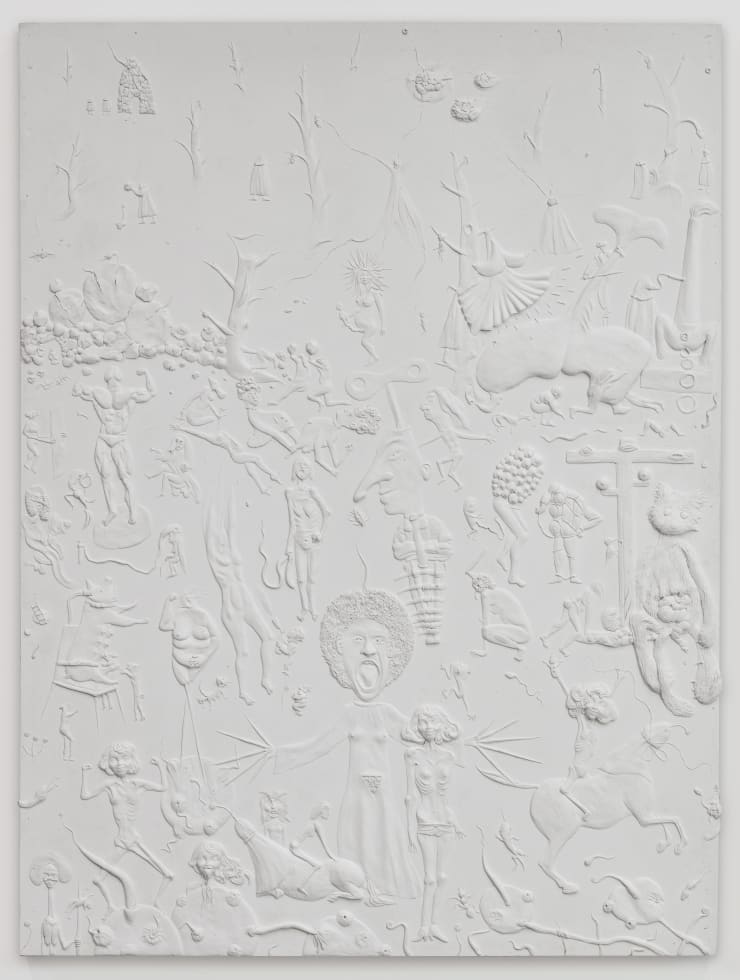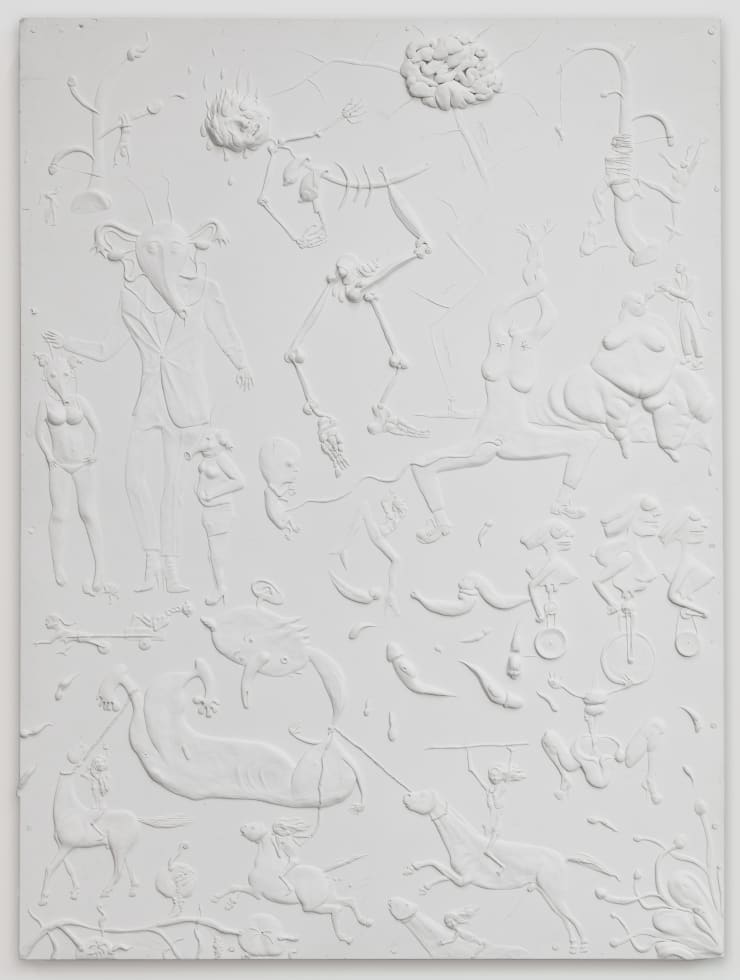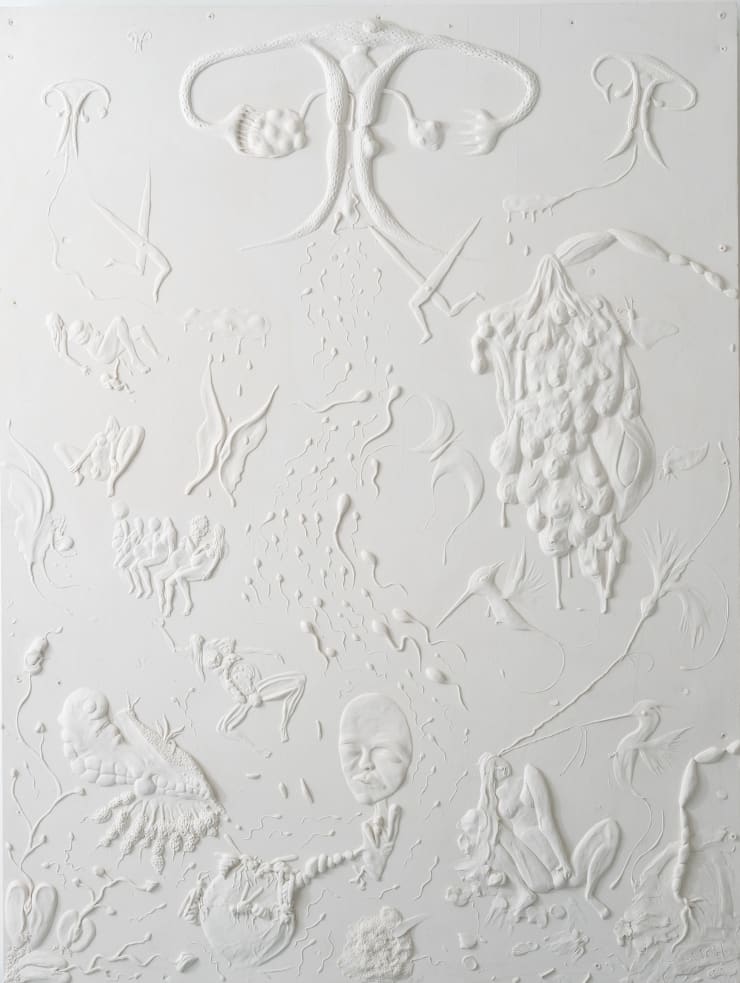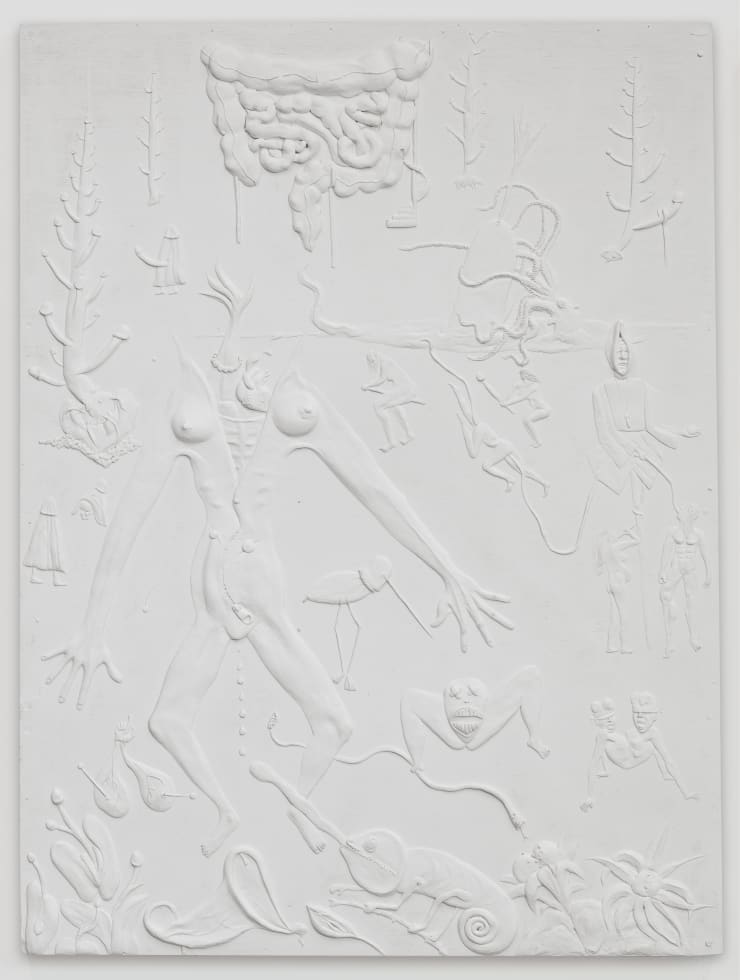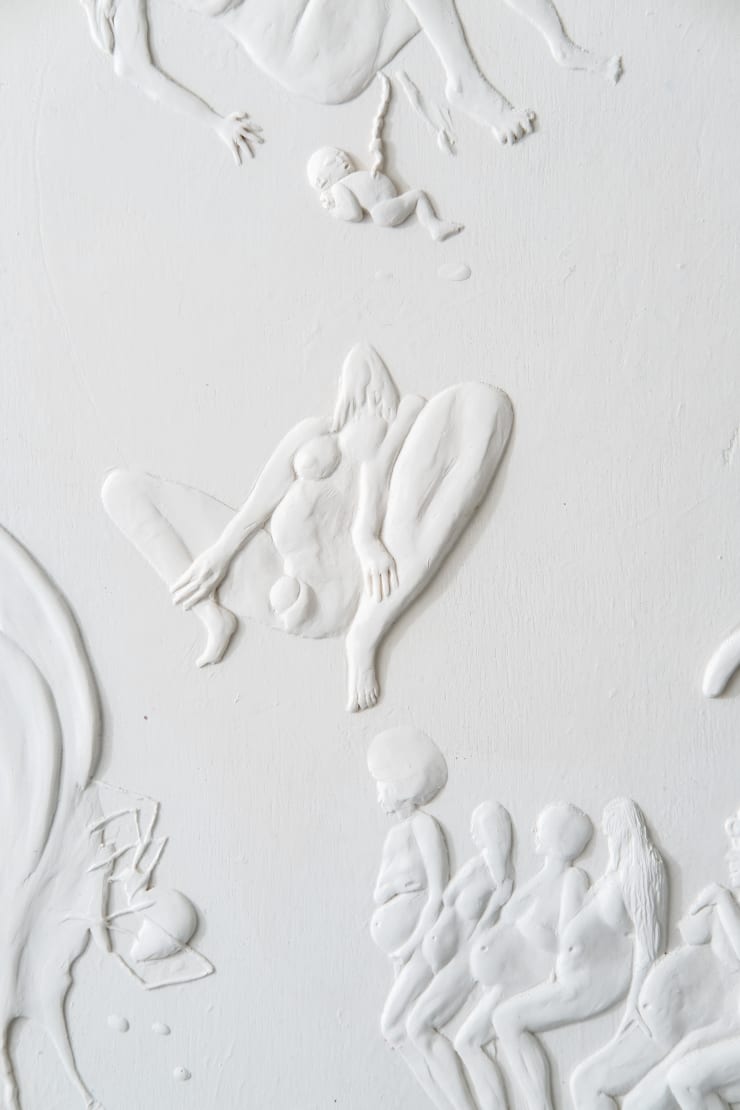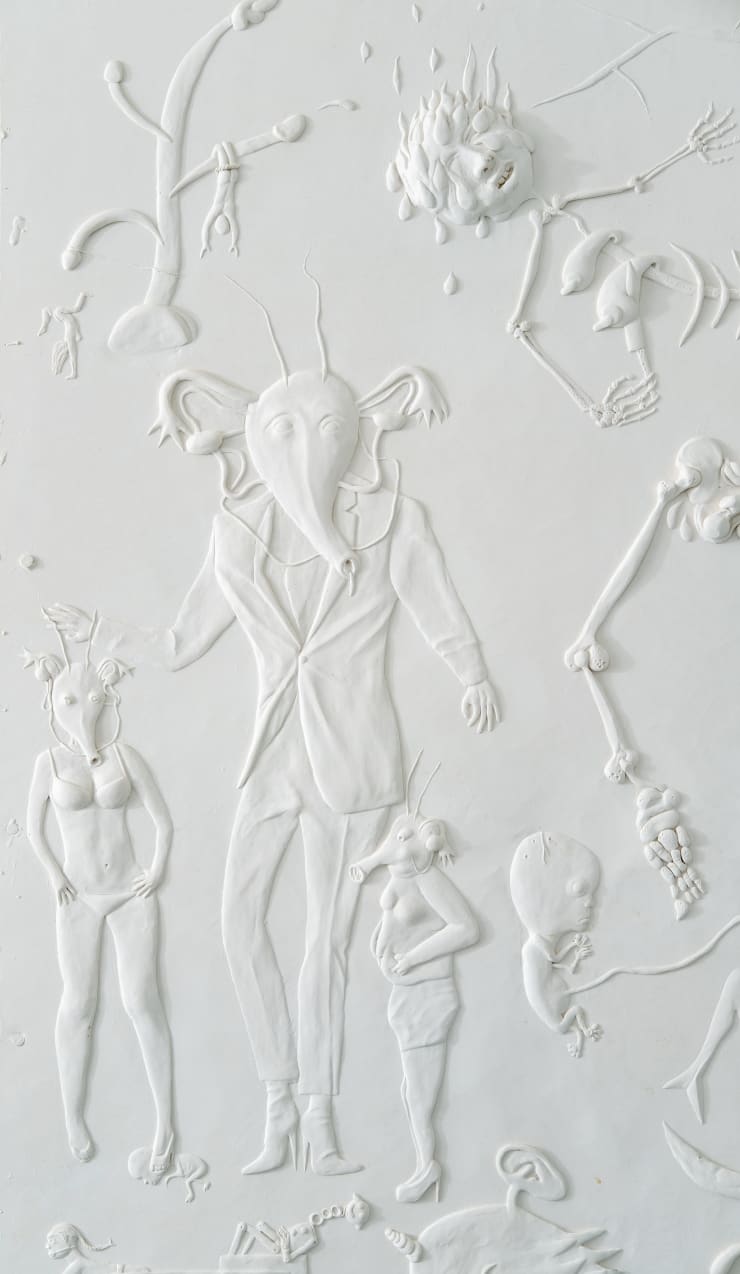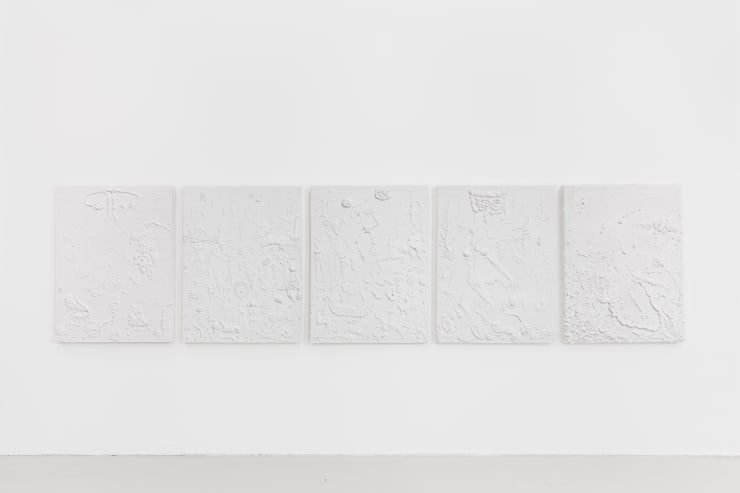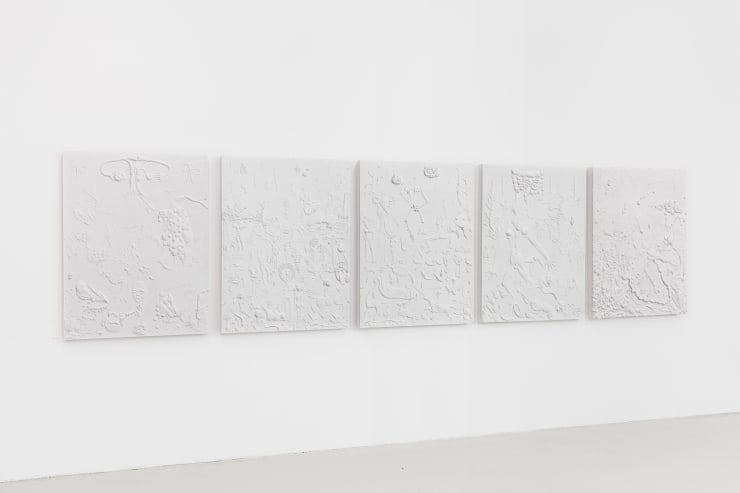Tim Noble I Focus on : IMAGINARY BEINGS
Galerie Kandlhofer is pleased to introduce Kandlhofer Focus a new section to the gallery program providing a platform for different artistic positions. The section will run concurrently with the gallery´s main exhibition program in the project room and focus on bringing a diverse range of artistic aesthetics and voices to the gallery to from a broader cultural and aesthetic dialogue.
Tim Noble is known for using unconventional materials (like trash) to make unexpected and unforgettable objects—the shadow sculptures, for example, with painstaking precision and craftsmanship. The juxtaposition of junk into highly wrought and mannerist portraits with his former partner, Sue Webster, were wondrous and magical in the transformation of one thing into another as if by legerdemain. In Noble’s latest body of solo work, the technical virtuosic skill has been redirected to times past; back so far in fact, as to touch upon wall reliefs more commonly found in ancient Egypt, Assyria and other Middle Eastern cultures than in today’s modes of contemporary art.
-
 Tim Noble, Imaginary Beings, 2020, Cast in jesmonite, each panel: 94.44 x 121.92 x 7.62 cm, 37 1/8 x 48 x 3 in, Edition 1/2 plus 1 APphotography curtesy: kunst-dokumentation.com
Tim Noble, Imaginary Beings, 2020, Cast in jesmonite, each panel: 94.44 x 121.92 x 7.62 cm, 37 1/8 x 48 x 3 in, Edition 1/2 plus 1 APphotography curtesy: kunst-dokumentation.com -
 Tim Noble, Imaginary Beings, 2020, Cast in jesmonite, each panel: 94.44 x 121.92 x 7.62 cm, 37 1/8 x 48 x 3 in, Edition 1/2 plus 1 APphotography curtesy: kunst-dokumentation.com
Tim Noble, Imaginary Beings, 2020, Cast in jesmonite, each panel: 94.44 x 121.92 x 7.62 cm, 37 1/8 x 48 x 3 in, Edition 1/2 plus 1 APphotography curtesy: kunst-dokumentation.com -
 Tim Noble, Imaginary Beings, 2020, Cast in jesmonite, each panel: 94.44 x 121.92 x 7.62 cm, 37 1/8 x 48 x 3 in, Edition 1/2 plus 1 APphotography curtesy of the artist
Tim Noble, Imaginary Beings, 2020, Cast in jesmonite, each panel: 94.44 x 121.92 x 7.62 cm, 37 1/8 x 48 x 3 in, Edition 1/2 plus 1 APphotography curtesy of the artist -
 Tim Noble, Imaginary Beings, 2020, Cast in jesmonite, each panel: 94.44 x 121.92 x 7.62 cm, 37 1/8 x 48 x 3 in, Edition 1/2 plus 1 APphotography curtesy: kunst-dokumentation.com
Tim Noble, Imaginary Beings, 2020, Cast in jesmonite, each panel: 94.44 x 121.92 x 7.62 cm, 37 1/8 x 48 x 3 in, Edition 1/2 plus 1 APphotography curtesy: kunst-dokumentation.com -
 Detail: Tim Noble, Imaginary Beings, 2020, Cast in jesmonite, each panel: 94.44 x 121.92 x 7.62 cm, 37 1/8 x 48 x 3 in, Edition 1/2 plus 1 AP, Image Credits: Robert Fairer
Detail: Tim Noble, Imaginary Beings, 2020, Cast in jesmonite, each panel: 94.44 x 121.92 x 7.62 cm, 37 1/8 x 48 x 3 in, Edition 1/2 plus 1 AP, Image Credits: Robert Fairer -
 Detail: Tim Noble, Imaginary Beings, 2020, Cast in jesmonite, each panel: 94.44 x 121.92 x 7.62 cm, 37 1/8 x 48 x 3 in, Edition 1/2 plus 1 AP, Image Credits: Robert Fairer
Detail: Tim Noble, Imaginary Beings, 2020, Cast in jesmonite, each panel: 94.44 x 121.92 x 7.62 cm, 37 1/8 x 48 x 3 in, Edition 1/2 plus 1 AP, Image Credits: Robert Fairer -
 Detail: Tim Noble, Imaginary Beings, 2020, Cast in jesmonite, each panel: 94.44 x 121.92 x 7.62 cm, 37 1/8 x 48 x 3 in, Edition 1/2 plus 1 AP, Image Credits: Robert Fairer
Detail: Tim Noble, Imaginary Beings, 2020, Cast in jesmonite, each panel: 94.44 x 121.92 x 7.62 cm, 37 1/8 x 48 x 3 in, Edition 1/2 plus 1 AP, Image Credits: Robert Fairer
Tim Noble is known for using unconventional materials (like trash) to make unexpected and unforgettable objects—the shadow sculptures, for example, with painstaking precision and craftsmanship. The juxtaposition of junk into highly wrought and mannerist portraits with his former partner, Sue Webster, were wondrous and magical in the transformation of one thing into another as if by legerdemain. In Noble’s latest body of solo work, the technical virtuosic skill has been redirected to times past; back so far in fact, as to touch upon wall reliefs more commonly found in ancient Egypt, Assyria and other Middle Eastern cultures than in today’s modes of contemporary art.
The thread of continuity lies in the subject matter of Noble’s recent pieces—as twisted, unsettling and demented as the man himself, and anything he has previously rendered. Death, destruction, dysmorphia and an unhinged spirit of juvenile delinquency erupt from the surface that is as off-putting as hilarious; yet, he manages to (seemingly) effortlessly get away with it all due to the subtlety of the so skin of the plaster and light barely-there touch in the process of their making.
The depths of our subconscious harbor a cesspool of obscure, paranoid and morally incorrect thoughts. Our imaginations are bombarded with barbarian urges and sexual deviations which, when not outright repressed and kept in a state of check, get spliced into new and fantastical scenarios. Noble nonchalantly mines these primal urges and inclinations revealing a fertile, fes- tering pool of characters and scenarios; and, beyond most mortals, he dares to expose them for our voyeuristic, guilty pleasures.
The artist has manifested these beings, in their rawest state, from the realm of frozen subjectivity that initially poured from the sluice of the mind’s eye, through his ngertips, manipulated in clay until they crystallized into reconcilable imagery. Initially, modelled on top of cheap boards of plywood in a version of 3D doodling, the panels took shape gradually over months. Eventually, they became filled with visions—the mistakes and doubt morphed into de nitive human and animal like explorations. As one piece lled, another took its place until the boards began to literately hemorrhage with detail.
Over a period, a landscape and vocabulary developed as each new panel became more and more dense, peopled with an over- populated mass evolved of erotic, neurotic, predatory creatures. Evolution is key here, some of the malevolent variety, while at other times more innocent. There is a female, menstruation blood dripping, her skin partially un-zipped exposing her beating, throbbing heart, while a chameleon with a penis for a head, wobbling in the breeze, mistakes the bodily fluids of the headless women for an insect, and lashes out with its tongue for nutrition.
The creatures of Noble’s forest are forced out of their natural habitat in favor of overpopulation in an unnatural, uncaring, inhuman world. Huge polyp plants (Noble’s nomenclature) resemble phalluses grown and nurtured by the female protagonists and farmed and celebrated for their own purposes. Progress has not been kind to the polyp plants, they become emasculated, tied in knots and eventually eradicated. Don’t shoot the messenger, I am just relating what I’ve seen!
Noble’s five panels resemble a bastardization of Wedgwood bas reliefs, Bosch a and Bruegel. He didn’t conjure this horror show purely from the ether—he resorted to online resources as much as ploughing through anatomical texts, porn mags, medical diagrams, images of anorexia—a host of human extremes, from the absurd to the ridiculous, and back.
The Elgin Marbles that once crowned the Parthenon, made under the supervision of the architect and sculptor Phidias and his assistants, were originally highly colorful before being stripped of their rich hues and stolen from the Greeks. They are now ex- hibited in the British Museum, decontextualized and denuded, but perhaps allowing the boldness of the carvings to overwhelm the senses even more. Not that that makes their misappropriation any less morally reprehensible.
In a parallel sense, Noble’s crazy, passionate nightmarish universe—on first blush calm, minimalistic and void of color—upon closer inspection reveals a vile underbelly you will not soon be able to purge from your head. Sweet dreams.
Text by Kenny Schachter
-
 Tim Noble, Imaginary Beings, 2020, Cast in jesmonite, each panel: 94.44 x 121.92 x 7.62 cm, 37 1/8 x 48 x 3 in, Edition 1/2 plus 1 AP. Photo: kunst-dokumentationen.com
Tim Noble, Imaginary Beings, 2020, Cast in jesmonite, each panel: 94.44 x 121.92 x 7.62 cm, 37 1/8 x 48 x 3 in, Edition 1/2 plus 1 AP. Photo: kunst-dokumentationen.com -

Tim Noble, Imaginary Beings, 2020, Cast in jesmonite, each panel: 94.44 x 121.92 x 7.62 cm, 37 1/8 x 48 x 3 in, Edition 1/2 plus 1 AP. Photo: kunst-dokumentationen.com

